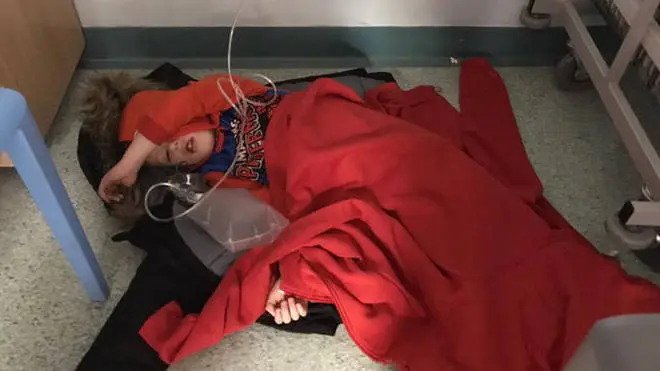
Ben Kentish 10pm - 1am
10 December 2019, 14:57

The editor of the newspaper which first revealed pictures of a boy laying on the floor of an A&E has defended the story against claims of “fake news.”
A Facebook post claiming the story of four-year-old Jack Williment-Barr, pictured wrapped in a blanket in the corner of Leeds General Infirmary, was fabricated went viral on Monday and proved a major black mark in the Tories' election campaign.
The Yorkshire Evening Post first broke the story on Sunday before the incident received further attention on Monday when Prime Minister Boris Johnson refused to look at the picture when it was shown to him by ITV journalist Joe Pike.
But later that day, a message claiming that a senior nurse at the hospital had discredited the story went viral across Twitter and Facebook.
I have responded in good faith to Margaret. I do hope we are not too late to help people like her, so unfairly manipluated and discombobulated by cynical social media messaging driven by dark forces. pic.twitter.com/VNhe89dZxz
— James Mitchinson (@JayMitchinson) December 10, 2019
The copied and pasted message read: "Very interesting. A good friend of mine is a senior nursing sister at Leeds Hospital - the boy shown on the floor by the media was in fact put there by his mother who then took photos on her mobile phone and uploaded it to media outlets before he climbed back onto his trolley."
The woman who wrote the original post claims her Facebook was hacked, and that she has received death threats as a result of being named online as the source.
After a reader contacted him about the claim that the story was fake, James Mitchinson, Johnston Press' editorial director for Yorkshire, tweeted a letter he had sent her outlining the newspaper's processes for verifying the story.
Mr Mitchinson said the paper had “immediately checked the veracity of the assertion with the hospital” and that they had “confirmed the set of circumstances you read in our story were and are correct.”
He added that the newspaper "went to great lengths to establish the story was true", adding: "I would be happy to meet you over a coffee to offer you an explanation as to how sophisticated and corrosive the proliferation of fake news is, and what to do to guard against being conned by it."
"I do hope we are not too late to help people like her, so unfairly manipulated and discombobulated by cynical social media messaging driven by dark forces," he said.
The story also hit headlines on Monday evening amid claims that a Labour activist had punched a Tory adviser outside the hospital, which turned out not to be true.
ITV Political Editor Robert Peston and BBC Political Editor Laura Kuenssberg were both forced to apologise after tweeting the claims, which came from “senior Tory sources.”
It is completely clear from video footage that @MattHancock's adviser was not whacked by a protestor, as I was told by senior Tories, but that he inadvertently walked into a protestor's hand. I apologise for getting this wrong.
— Robert Peston (@Peston) December 9, 2019
While it is difficult to verify the original source of the attempts to discredit the photo, researchers at anti-disinformation group First Draft found several hundred copies of the message across Facebook and Twitter, including shares by prominent celebrities and journalists.
Alastair Reid, digital editor at First Draft, told PA: "Both on Facebook and Twitter we've seen a concerted effort to put this claim in front of as many people as possible.
"On Twitter that has meant accounts have been contacting celebrities, athletes, journalists and politicians and telling them to share it. On Facebook we have seen the same paragraph of text pushed into pro-Brexit and pro-Conservative Facebook groups again and again and again."
However, he urged people to steer clear of talk of "bots" - or automated accounts - driving the conversation.
"At this stage it's very difficult to say whether there is any automated or co-ordinated activity and it's better not to jump to conclusions," he added.